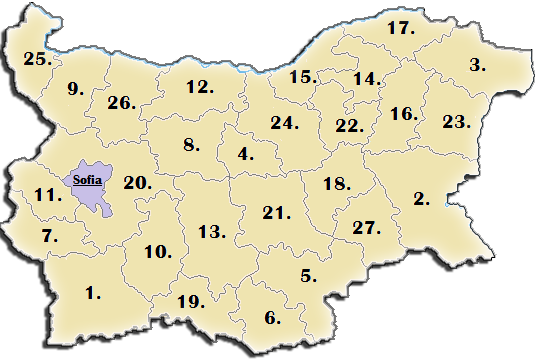Bulgaria
|
|

Basic Info
Bulgaria, officially the Republic of Bulgaria, is a country located in Southeastern Europe. It is bordered by Romania to the north, Serbia and Macedonia to the west, Greece and Turkey to the south and the Black Sea to the east. With a territory of 110,994 square kilometres (42,855 sq mi), Bulgaria is Europe's 14th-largest country. Its location has made it a historical crossroad for various civilisations and as such it is the home of some of the earliest metalworking, religious and other cultural artifacts in the world.

Geography
Bulgaria occupies a portion of the eastern Balkan peninsula, bordering five countries—Greece and Turkey to the south, Macedonia and Serbia to the west, and Romania to the north. The land borders have a total length of 1,808 kilometres (1,123 mi), and the coastline has a length of 354 kilometres (220 mi). Its total area of 110,994 kilometres (68,968 mi) ranks it as the world's 105th-largest country. Bulgaria's geographic coordinates are 43° N 25° E.
Climate
Bulgaria has a dynamic climate, which results from its being positioned at the meeting point of Mediterranean and continental air masses and the barrier effect of its mountains. Northern Bulgaria averages 1 °C (34 °F) cooler and registers 200 millimetres (7.9 in) more annually than the regions south of the Balkan mountains. Temperature amplitudes vary significantly in different areas. The lowest recorded temperature is −38.3 °C (−36.9 °F), while the highest is 45.2 °C (113.4 °F). Precipitation averages about 630 millimetres (24.8 in) per year, and varies from 500 millimetres (19.7 in) in Dobrudja to more than 2,500 millimetres (98.4 in) in the mountains. Continental air masses bring significant amounts of snowfall during winter.
Administrative divisions
Bulgaria is a unitary state. Since the 1880s, the number of territorial management units has varied from seven to 26. Between 1987 and 1999 the administrative structure consisted of nine provinces (oblasti, singular oblast). A new administrative structure was adopted in parallel with the decentralisation of the economic system. It includes 27 provinces and a metropolitan capital province (Sofia-Grad). All areas take their names from their respective capital cities. The provinces subdivide into 264 municipalities.
|
 |
|
Site Search
News
Random Articals
Weather
Join Our Newsletter
Send This Page to Friend
To Email this page to a friend
1. Use Your Default Email Client
2. Use Our Recommend Page
Online Contact
nouahsark
1438084734
+ 86 158 00 323 707
+ 86 158 00 323 707
nouahsark@hotmail.com

If you like this article please feel free to share it to your favorite site listed below: